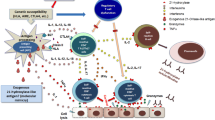Abstract
Wilson’s disease is an autosomal recessive disorder of copper accumulation in various organs, with most common clinical manifestations such as hepatic, neurological, and renal dysfunctions. Serum copper and ceruloplasmin in Wilson’s disease were significantly lower as compared to normals, controls, and relatives of Wilson’s disease patients, whereas marked hypercupriuria (145 ± 7 μg/24 h) was observed in Wilson’s children only. A good correlation (r = 0.92) was found between non-ceruloplasmin-bound copper and 24-h urinary copper excretion in Wilson’s disease patients. Further, copper studies among the different phenotypes of Wilson’s disease revealed substantially low serum ceruloplasmin and a marked hypercupriuria in Wilson’s disease children associated with renal tubular acidosis as compared to the patients with either hepatological or neurological manifestations. Serum ceruloplasmin levels in 14 patients of Wilson’s disease were between 14 and 20 mg/dL. These patients of Wilson’s disease were confirmed by measuring liver biopsy copper, which was about nine times higher than normal hepatic copper content. During the family screening by copper studies, four asymptomatic siblings were diagnosed for Wilson’s disease. These subjects were then started on D-penicillamine therapy because presymptomatic treatment prevents progression of the disease complications.
Similar content being viewed by others
References
I. Bremner and J. H. Beattie,Annu. Rev. Nutr. 10, 63 (1990).
M. C. Linder and M. Hazegh-Azam,Am. J. Clin. Nutr. 63, 7975 (1996).
D. M. Danks, Disorder of copper transport, inThe Metabolic Basis of Inherited Disease, 6th ed., C. R. Scriver, A. L. Beaudet, W. S. Sly, and D. Valle, eds., McGraw-Hill, New York, pp. 1411 (1989).
Y. Yamaguchi, M. E. Heiny, and J. D. Gittin,Biochem. Biophys. Res. Commun. 197, 271 (1993).
P. C. Bull, G. R. Thomas, J. M. Rommens, J. R. Forbes, and D. W. Cox,Nature Genet 5, 327 (1993).
I. H. Scheinberg and I. Sternlieb, Wilson’s disease,Major Problems in Internal Medicine, in L. H. Smith, ed., W.B. Saunders, Philadelphia, Vol. 23 (1984).
F. C. Yarze, P. Martin, S. J. Munoj, and L. S. Friedman,Am. J. Med. 92, 645 (1992).
W. Stremmel, K. W. Meyerrose, C. Niederau, C. Hefter, P. Kreuzpainter, and G. Strohmeyer,Ann. Intern. Med. 115, 720 (1991).
D. K. Manghani and D. K. Dastur,Ind. J. Gastroenterol. 4, 91 (1985).
R. Prasad, G. Kaur, R. Nath, and B. N. S. Walia,Mol. Cell. Biochem. 156, 25 (1996).
H. A. Ravin,J. Lab. Clin. Med. 56, 101 (1961).
R. Prasad, J. L. Kinsella, and B. Sacktor,Am. J. Physiol. 255, F1183 (1988).
P. S. Chen, T. Y. Toribara, and H. Warner,Anal. Chem. 28, 176 (1956).
C. J. Gubler, H. Brown, and H. Markowitz,J. Clin. Invest. 32, 405 (1953).
D. W. Cox, F. C. Fraser, and A. Sass-Kortsak,Am. J. Hum. genet. 24, 546 (1972).
L. E. Mallette and R. Aquaron,Clin. Chim. Acta 132, 245 (1983).
R. S. Graul, O. Epstein, S. Sherlock, and P. J. Scheurer,Liver 2, 207 (1982).
L. Barrow and M. S. Tanner,Eur. J. Clin. Invest. 18, 555 (1988).
J. M. Walshe,Quart. J. Med. New Series 70, 253 (1989).
S. Lau and B. Sarkar,Can. J. Biochem. Cell. Biol. 62, 449 (1984).
M. J. Czaja, F. R. Weiner, S. J. Schwarzenberg, I. Sternlieb, I. H. Scheinberg, D. H. Vanthiel, et al.,J. Clin. Invest. 80, 1200 (1987).
E. Azizi, G. Eshel, and M. Aladjem,Eur. J. Pediatr. 148, 548 (1989).
M. G. Cogan and F. C. Rector, Acid-base disorders: verification and calculation of acid-base parameters, inThe Kidney, 4th ed., B. M. Bremner and F. C. Rector, Jr., eds., W.B. Saunders, Philadelphia, Vol.I, pp. 752 (1991).
I. H. Scheinberg and I. Sternlieb,Am. J. Clin. Nutr. 63, 8425 (1996).
S. A. Zargar, B. R. Thapa, A. Sahni, and S. Mehta,Indian J. Gastroenterol. 10, 101 (1991).
D. Frommer, J. Morris, S. Sherlock, J. Abrams, and S. Newman,Gastroenterology 72, 1331 (1977).
Author information
Authors and Affiliations
Rights and permissions
About this article
Cite this article
Prasad, R., Kaur, G. & Walia, B.N.S. A critical evaluation of copper metabolism in indian wilson’s disease children with special reference to their phenotypes and relatives. Biol Trace Elem Res 65, 153–165 (1998). https://doi.org/10.1007/BF02784267
Received:
Revised:
Accepted:
Issue Date:
DOI: https://doi.org/10.1007/BF02784267




